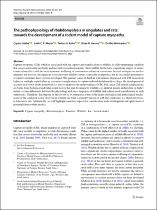| dc.contributor.author | Kohn, Tertius A | |
| dc.contributor.author | Lubbe, Crystal | |
| dc.contributor.author | Meyer, Leith C. R | |
| dc.date.accessioned | 2024-01-26T13:29:38Z | |
| dc.date.available | 2024-01-26T13:29:38Z | |
| dc.date.issued | 2023 | |
| dc.identifier.citation | Lubbe, C., Meyer, L.C., Kohn, T.A., Harvey, B.H. and Wolmarans, D.W., 2023. The pathophysiology of rhabdomyolysis in ungulates and rats: Towards the development of a rodent model of capture myopathy. Veterinary Research Communications, 47(2), pp.361-371. | en_US |
| dc.identifier.issn | 01657380 | |
| dc.identifier.uri | http://hdl.handle.net/10566/9275 | |
| dc.description.abstract | Capture myopathy (CM), which is associated with the capture and translocation of wildlife, is a life-threatening condition that causes noteworthy morbidity and mortality in captured animals. Such wildlife deaths have a significant impact on nature conservation efforts and the socio-economic wellbeing of communities reliant on ecotourism. Several strategies are used to minimise the adverse consequences associated with wildlife capture, especially in ungulates, but no successful preventative or curative measures have yet been developed. The primary cause of death in wild animals diagnosed with CM stems from kidney or multiple organ failure as secondary complications to capture-induced rhabdomyolysis. Ergo, the development of accurate and robust model frameworks is vital to improve our understanding of CM. Still, since CM-related complications are borne from biological and behavioural factors that may be unique to wildlife, e.g. skeletal muscle architecture or flighty nature, certain differences between the physiology and stress responses of wildlife and rodents need consideration in such endeavours. Therefore, the purpose of this review is to summarise some of the major etiological and pathological mechanisms of the condition as it is observed in wildlife and what is currently known of CM-like syndromes, i.e. rhabdomyolysis, in laboratory rats. Additionally, we will highlight some key aspects for consideration in the development and application of potential future rodent models. | en_US |
| dc.language.iso | en | en_US |
| dc.publisher | Springer | en_US |
| dc.subject | Capture myopathy | en_US |
| dc.subject | Rhabdomyolysis | en_US |
| dc.subject | Exertion | en_US |
| dc.subject | Wildlife | en_US |
| dc.subject | Animal model | en_US |
| dc.title | The pathophysiology of rhabdomyolysis in ungulates and rats: towards the development of a rodent model of capture myopathy | en_US |
| dc.type | Article | en_US |

